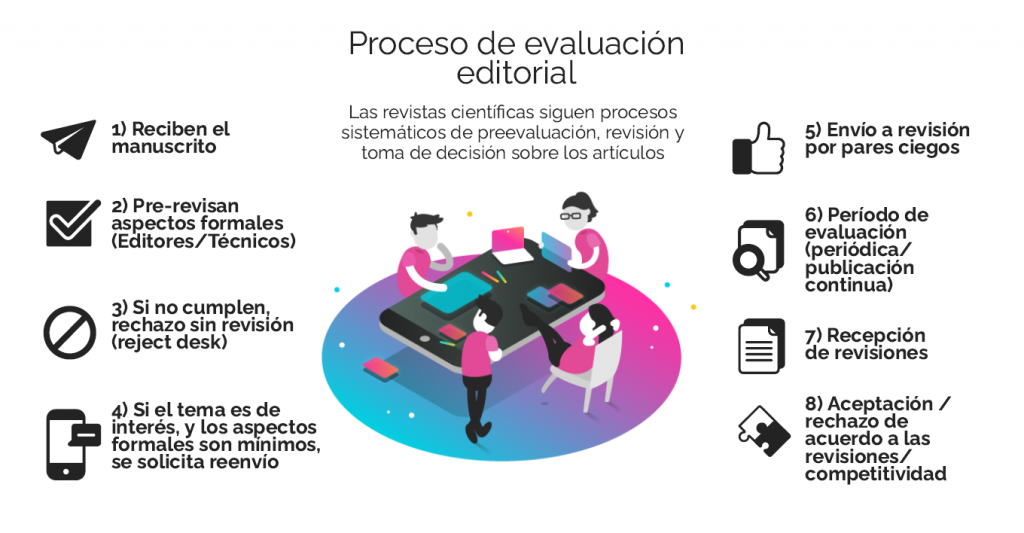Author: Arantxa Vizcaíno-Verdú– Translation: Erika-Lucia Gonzalez-Carrion
Completing a scientific article and submitting it to a journal can be a long and rewarding journey to publication. However, the length of that journey can be frustrating and make waiting for a response from editors tedious and, in some cases, disappointing. It is for this reason that, as researchers, it is important for us to be aware of the editorial procedures to which a scientific manuscript is subjected.
Generally, researchers need to publish their work diligently. This impatience, of which editors are wise connoisseurs, often overlooks the rigorous and detailed system carried out from the reception of the manuscript. As authors, it is essential to understand that this procedure is not trivial, since it involves, in most cases, an essential voluntariness (both editorial and review) to ensure the publication of the work. Authors can facilitate this process by following the journal’s instructions with precision, consistency and deference. So, what are the phases to which our article is submitted?
Editorial phases of the manuscript in a scientific journal

- Receipt of the manuscript. In the first instance, the editorial team receives the work through its platform, which is entirely the responsibility of the authors. The authors are responsible for rigorously complying with the journal’s regulations, submitting the files according to its guidelines.
- 2.Pre-revision of the manuscript. Secondly, the editorial team pre-evaluates that the manuscript complies with all the formal, methodological and thematic criteria, delimited both in its regulations and in its publications. It is essential to check this series of issues in advance, since rejection without peer review for not complying with the technical aspects of the guidelines is very common. Of course, this pre-evaluation does not imply a full, complete and in-depth reading of the manuscript, as this task is the responsibility of the reviewers (see fourth phase).
- Estimate phase for review / rejection without review. If the manuscript complies in technical, thematic and methodological terms with all the issues contemplated by the journal, the work will be sent for external evaluation by blind peers (according to regulations). Otherwise, if any or none of the delimited factors are not met, it may be rejected without evaluation. It is also possible that, if the non-compliance with the formal aspects is minimal, the authors may correct the issues indicated for resubmission and pre-evaluation. Rejections at this stage are especially frequent due to the current climate of overload of reviewers, ensuring their voluntary dedication, submitting potentially publishable papers according to criteria and concordance of scientific quality.
- Manuscript revision. This phase is usually extended according to the availability of the assigned reviewers, as well as to the constant supervision by the editorial board so that they are undertaken, following the Code of Ethics, with the deadlines and criteria established by regulations. In this case, many journals usually publish their evaluation deadlines, being the responsibility of the corresponding author to follow up and, in case of unjustified delay, to request an update.
- Receipt of evaluations. The different international editorial boards develop this phase in multiple ways. However, it is always the reviewers who make the editorial decision, justified in a transparent, anonymous and respectable manner by the editorial board. It is important to take into consideration these evaluations, whose background involves the time and dedication of the experts.
Acceptance / rejection of the article. Finally, we receive the long-awaited decision. At this point we will have to carefully review the reviewers’ recommendations, paying attention to the viable and coherent suggestions for improvement. In case of acceptance, it is important to rigorously follow the changes requested by both editors and reviewers, in view of the pre-publication editorial process (whether minor or major changes are requested, with their corresponding justification and re-evaluation). In case of rejection, it is the authors’ duty to reflexively review the evaluators’ considerations. Despite possible discrepancies between reviewers, it is important to review the issues that can be assumed for improvement and consequent resubmission to another journal.
